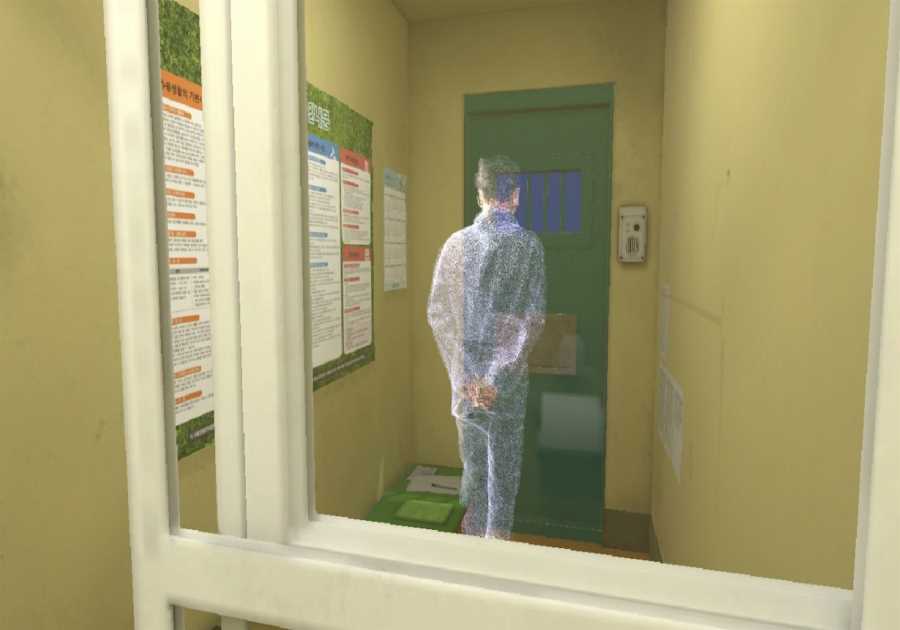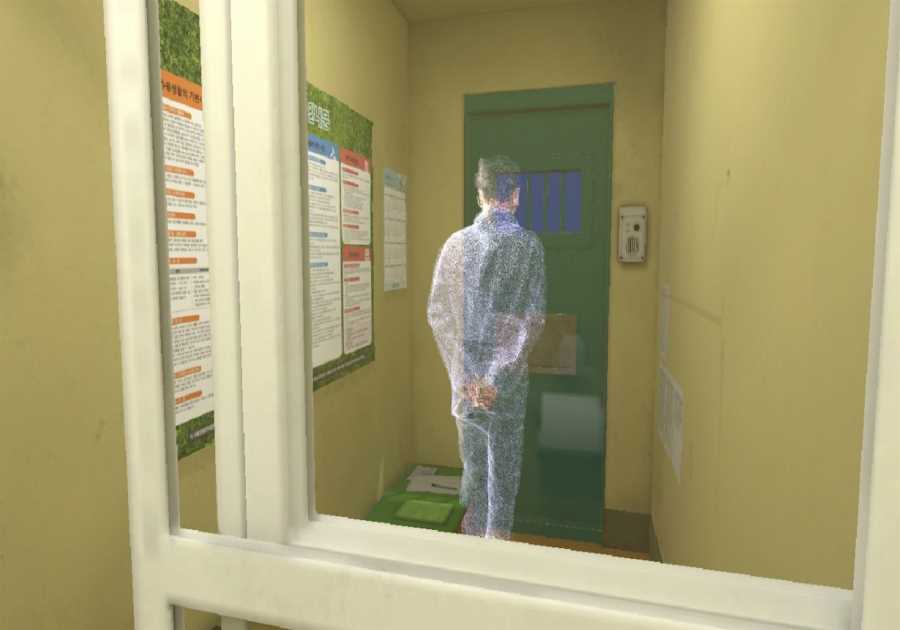The IT buyers who think the Lenovo ThinkPad X1 Carbon is the pinnacle of thin-and-light business laptops will have to think again. The new ThinkPad X1 Titanium Yoga (starts at $1,769.40; $2,021.40 as tested) re-imagines the classic executive notebook. This svelte 2-in-1 laptop is heavier than the feather-like ThinkPad X1 Nano, but it’s still by far the thinnest convertible ThinkPad yet, rising just 0.45 inch from the corner-office desk. The redesigned keyboard might give ThinkPad traditionalists pause, but companies or individual professionals willing to stomach the high list price will find a capable business machine packed with innovation.
Any Color, as Long as It’s Titanium
Denizens of the corporate world like ThinkPads in part because their rugged black chassis have changed so little over the years. Lately, however, the ThinkPad line’s current owner, Lenovo, has been shaking things up. The X1 Titanium Yoga is the tech giant’s latest effort. The new laptop comes only in a light Titanium color scheme, doing away with the black finishes of the X1 Carbon and other previous ThinkPad flagships.
It’s a Yoga, which means it has a 360-degree rotating hinge that lets you transform it into an easel, a tent, or a tablet. That’s been standard fare for some ThinkPads for a while; there’s already a ThinkPad X1 Yoga for sale, now in its fifth generation, with a sixth generation announced alongside the Titanium. Apart from being much thinner and lighter (it weighs 2.5 pounds) than the X1 Yoga, the X1 Titanium’s unique screen sets it apart. It’s a 13.5-inch touch-enabled display with a 450-nit backlight and a 3:2 aspect ratio, which makes it taller and narrower than the 16:9 widescreen orientation on most current ThinkPads. The additional height lets you view more of a text document or web page before you need to scroll, a boon to swamped executives reviewing memos all day long.
The 3:2 aspect ratio is also making a comeback on other ultraportable laptops; we’ve seen a handful of such models introduced over the past year. Before the advent of widescreen video, the 3:2 aspect ratio was more common on laptops. In fact, you could even argue that the X1 Titanium is a bit of a throwback to the late 1990s and early 2000s, when widescreens hadn’t entered the mainstream yet and ThinkPads were first ascending to stardom.
I find the X1 Titanium’s screen to be above average in all respects. (It should be, given the asking price!) I especially appreciate the QHD resolution, which measures 2,256 by 1,504 pixels. Positioned between full HD and 4K, this resolution offers crisp text without being overkill for professionals who presumably won’t spend much time watching 4K movies. As for the squarish aspect ratio, I appreciated it most while using the device as a tablet, with the keyboard folded 360 degrees. When you rotate a 16:9 convertible to the portrait orientation, it becomes a long, thin tablet that’s really only useful for scrolling through web pages. The 3:2 ratio is more versatile in Tablet mode.
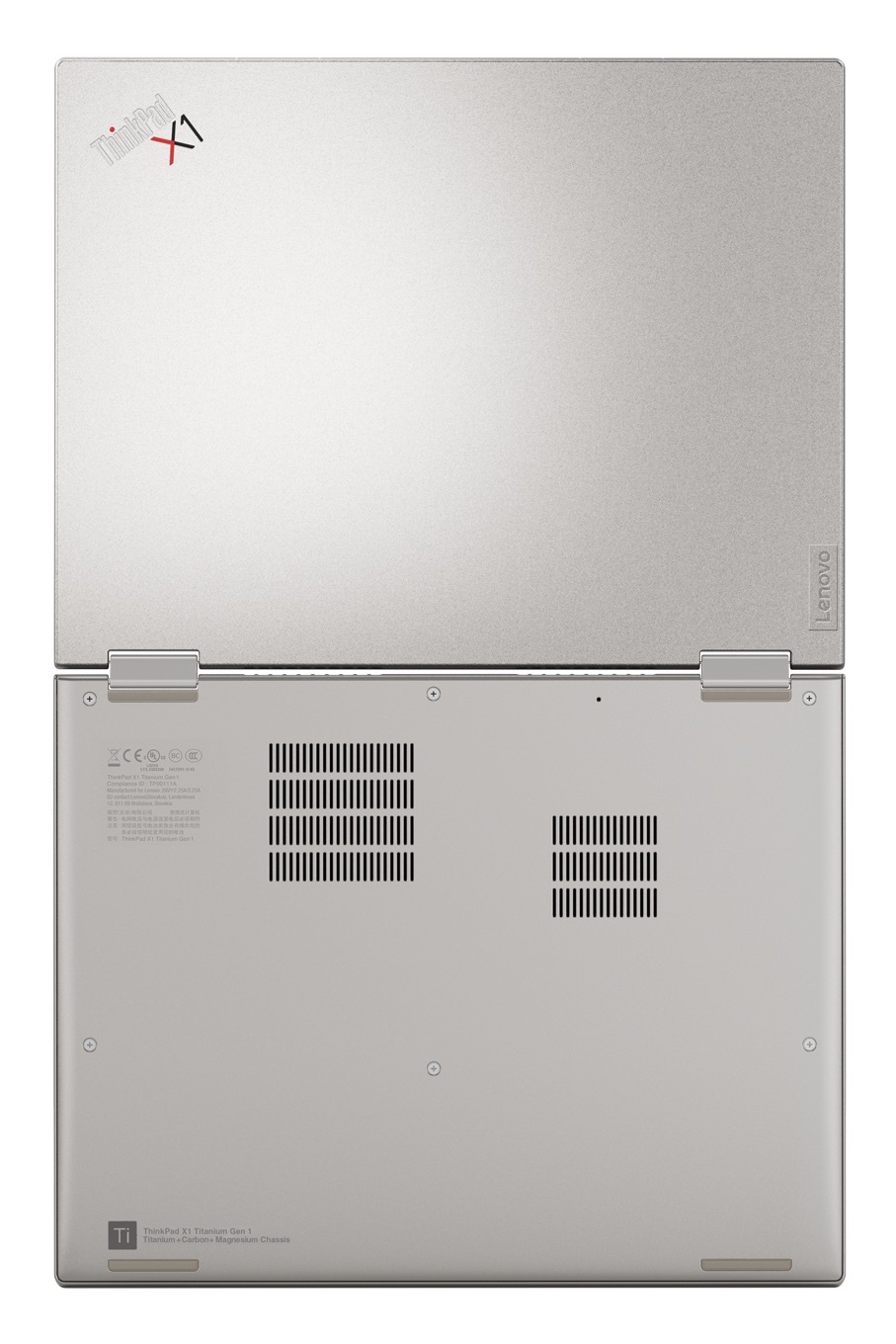
The 3:2 aspect ratio is making a comeback. Credit: Lenovo
Cutting-Edge Enterprise Features
The ThinkPad X1 Titanium Yoga has many cutting-edge business-friendly features you’d expect from a laptop that costs this much. They include user-friendly innovations like a webcam that includes both IR sensors for face recognition logins via Windows Hello and a reassuring shutter for privacy. These components necessitate a bit of extra space between the top of the screen and the edge of the laptop, which means the interior looks a bit less cutting-edge than, say, the most recent iterations of the Dell XPS 13 (whose pixels practically drip off the sides of the laptop).
The camera works in tandem with the laptop’s proximity sensor and IR sensor to detect when you approach, automatically awaken from sleep mode, and log you in via face recognition. You can also use the small fingerprint reader mounted above the keyboard’s upper right corner to log in to your Windows account.
Inside the X1 Titanium Yoga, there are plenty of features that IT staffers will appreciate, including the option for brand-new 11th Generation Core processors with vPro remote management and security features. The review unit Lenovo sent us has a Core i5-1130G7 CPU from the latest “Tiger Lake” family, coupled with 16GB of RAM and a 512GB SSD. These are underwhelming specs for a laptop that costs this much.
Buyers will be able to order configurations with 8GB of RAM, as well as 256GB or 1TB SSDs. There are also three additional processor options: a Core i5 with vPro support, and two Core i7 models (one with vPro and one without). The addition of vPro processors is often key to adoption by Fortune 500 companies and other large corporations who deploy and manage large laptop fleets. Intel claims the new 11th Generation Core processors with vPro offer 20% better performance overall than the 10th Generation ones they replace.
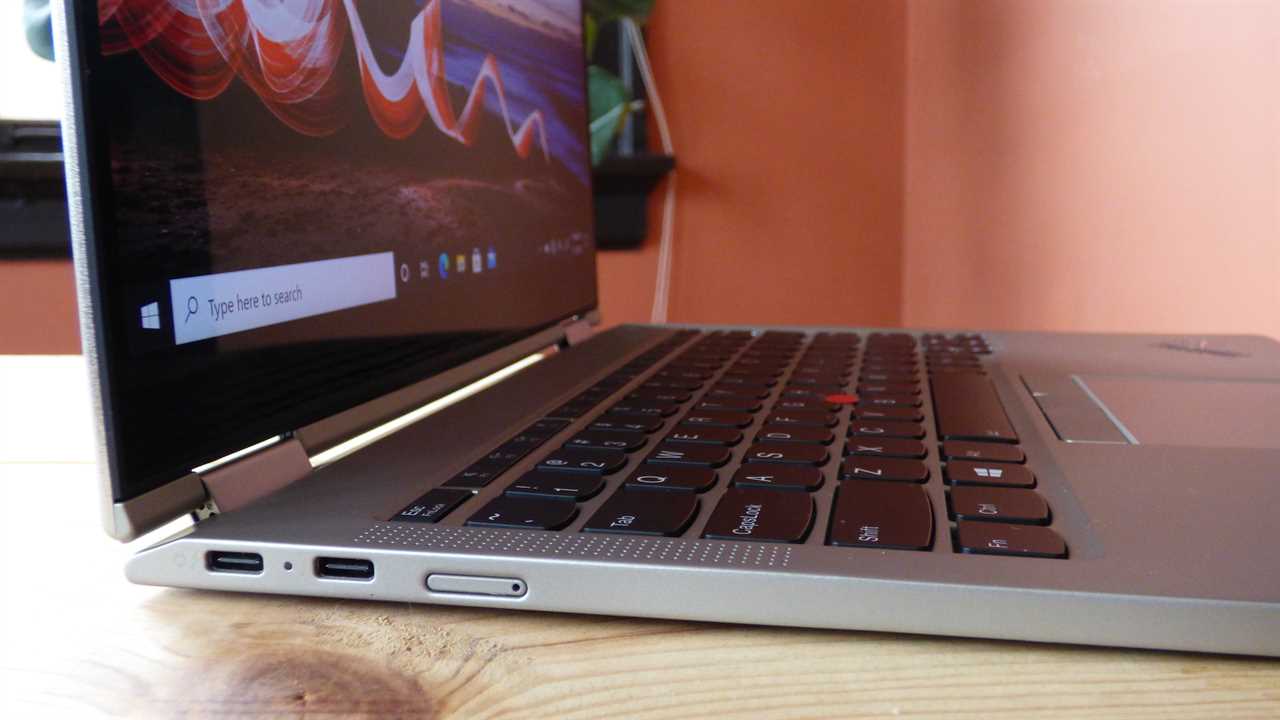
Despite all the business-friendly features the X1 Titanium Yoga does have, there are still a few key ones missing. Chief among the absent is a full-size HDMI port for physical connections to conference-room and lecture-hall A/V systems. (The chassis is far too thin for such a large port.) Instead, the only physical connections the X1 Titanium offers are two USB Type-C ports, a SIM card slot for the optional 5G/LTE modem, and a headphone jack.
Sure, you can easily order a USB-C-to-HDMI adapter or cable, but that’s one more thing to remember before you embark on your next business trip (which, judging by the still-raging COVID-19 pandemic, might not be for a while).
Hey, What Happened to the Keyboard?
The most controversial X1 Titanium Yoga features by far are the keyboard and the touchpad. These two traditional means of input are important to ThinkPad users, and Lenovo has radically altered them in this new laptop, starting with the touchpad. It ditches the traditional physical clicking switch, instead opting for a haptic feedback that simulates physical clicks with tiny vibrations. This technology has been around for a few years on Apple laptops, where it works quite well. Lenovo’s version relies on technology from a small company called Sensel, whose design integrates the haptic motor sensors, and all of the other touchpad components, into a single package. This compact design is a key reason why the X1 Titanium could be made so thin.
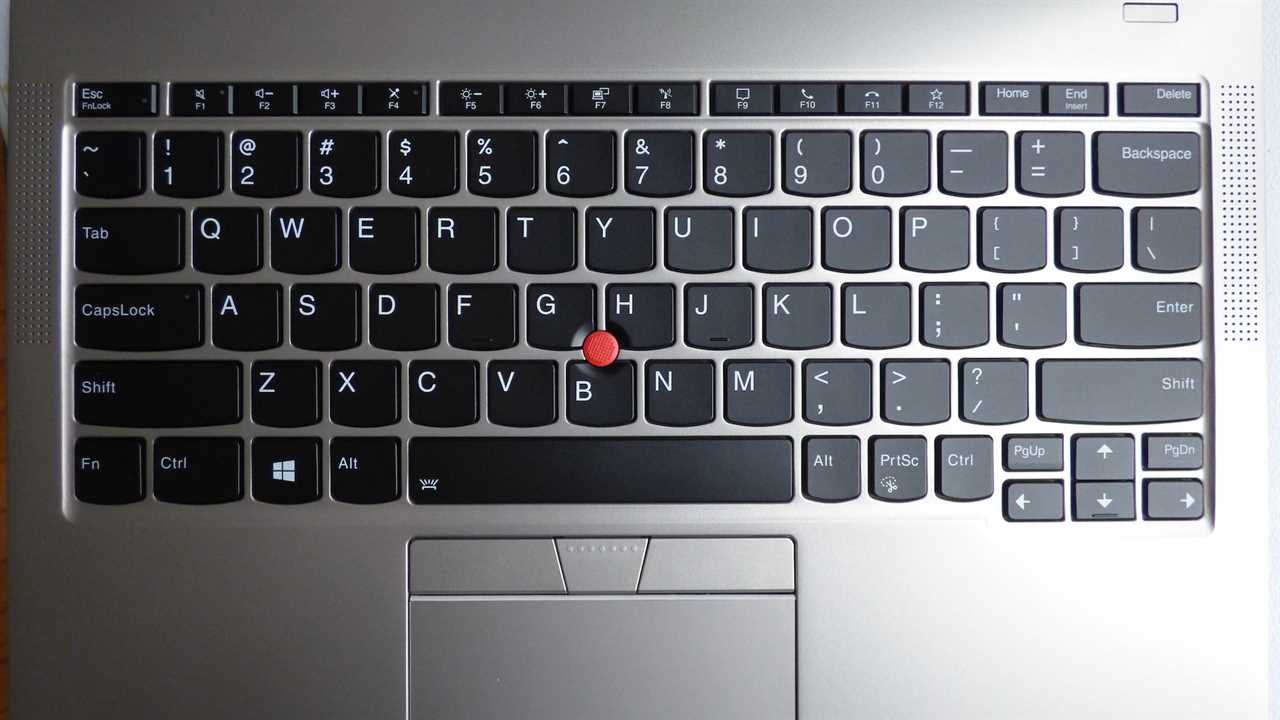
Sensel offers a few settings in a standalone app on the X1 Titanium. They include setting the threshold for finger detection and clicking, as well as adjusting the intensity of haptic feedback or disabling it entirely. These are similar to the options that MacBooks offer, but in general I find tapping and haptic clicks to be somewhat less precise on the X1 Titanium. There are no such problems with tapping on the touch-enabled screen, which accepts input either from your fingers or from the Lenovo Precision Pen digital stylus that’s included in the box. The X1 Titanium’s keyboard isn’t as unusual as the touchpad, but given how strongly many ThinkPad owners care about the typing experience, it’s potentially more controversial. Lenovo ditches the luxurious keys and travel distance that are endemic to ThinkPads in favor of a shallower, stiffer keyboard. The keys and keyboard layout are virtually indistinguisable from those of other ThinkPads, but the travel distance feels slightly shorter than it does on the X1 Yoga or X1 Carbon, or any other ThinkPad laptop I’ve tried. The overall feeling is more akin to how typing feels on the XPS 13 or the previous-generation MacBook Pro and MacBook Air equipped with butterfly-style switches. With 1.35mm of travel distance, it’s slightly better than the tapping effect of the older Macs, but not by much. At least there’s still a red TrackPoint in the middle of the keyboard.
On the other hand, there are plenty of younger millennials entering the corporate world now who have experience using Apple’s butterfly switches and aren’t put off by them. So while the X1 Titanium’s board won’t please typing purists, neither is it unequivocally a misstep.
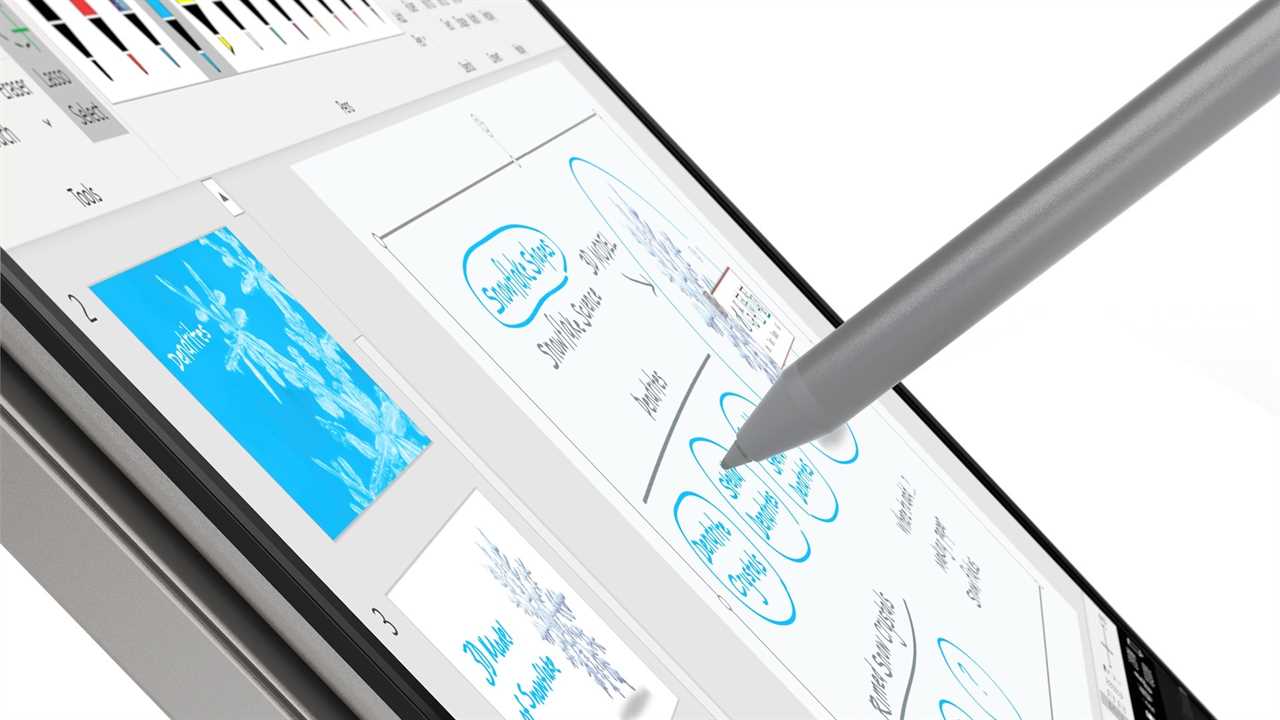
The Lenovo Precision Pen digital stylus is included in the box. (Image: Lenovo)
X1 Titanium users shouldn’t expect great audio quality, since there’s really no room in the chassis for powerful speakers. As it stands, the twin 2-watt speakers offer passable sound for video conferences. They’re complemented by an impressive four-microphone array, part of which is dedicated to improving noise cancellation so that the person on the other end of the Zoom call can hear your voice more clearly above background noise.
Lenovo supports the X1 Titanium with a one-year warranty. That’s shorter than the three years of standard coverage that typically come with corporate laptops from HP and Dell that are priced around $2,000.
Testing the ThinkPad X1 Titanium Yoga: Small Laptop, Big Performance
One of the potential downsides of a thin laptop chassis is that there’s less room to dissipate heat, which in turn can require throttling the computing components and reducing performance. Thanks partly to what sounds like a powerful cooling fan, the X1 Titanium mostly manages to avoid this. The fan was clearly audible during my entire time testing the laptop, but I never once experienced lags or sluggishness while browsing the web or installing complex apps like Adobe Photoshop.
The X1 Titanium’s results on our benchmark tests show that it can hold its own when compared with the performance of similarly priced 2-in-1 laptops aimed at business users. Comparable systems include the Dell Latitude 7320 2-in-1, the HP EliteBook x360 1040, the ThinkPad X1 Yoga, and the Microsoft Surface Pro 7+. With the exception of the Surface Pro, all of these systems are much heavier than the X1 Titanium, though they’re all priced between $1,500 and $2,500.
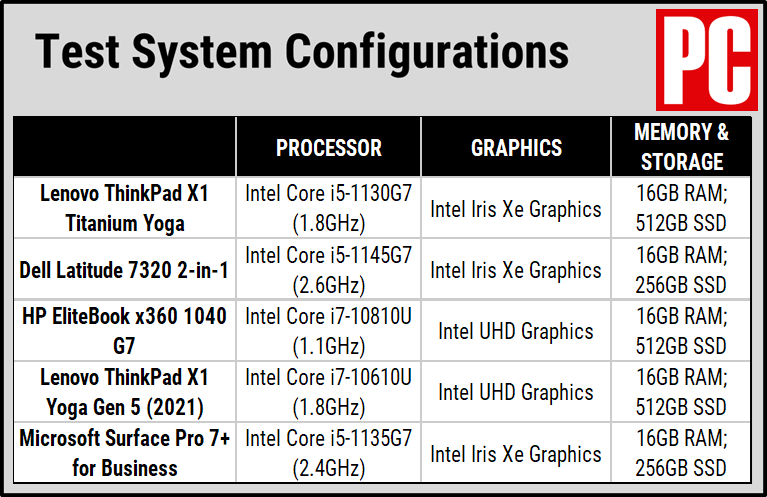
Anything over 4,000 represents excellent performance on the PCMark 10 test, and the X1 Titanium has no trouble clearing this hurdle. The PCMark 10 test we run simulates different real-world productivity and content-creation workflows. We use it to assess overall system performance for office-centric tasks such as word processing, spreadsheet jockeying, web browsing, and videoconferencing. (See more about how we test laptops.)
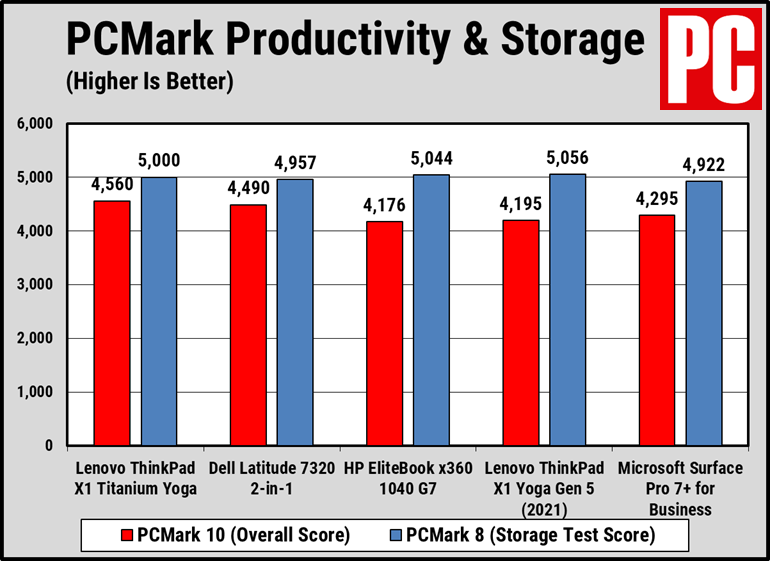
PCMark 8, meanwhile, has a Storage subtest that we use to assess the speed of the system’s storage subsystem. With a speedy SSD, the X1 Titanium again has no trouble posting an excellent result.
When performing a sustained task that requires lots of CPU power, such as encoding a 4K video to 1080p, the X1 Titanium turns in a last-place finish, but it’s still in line with what its competitors manage. Our video-encoding trial uses the Handbrake app and is a tough, threaded workout that’s highly CPU-dependent and scales well with cores and threads.
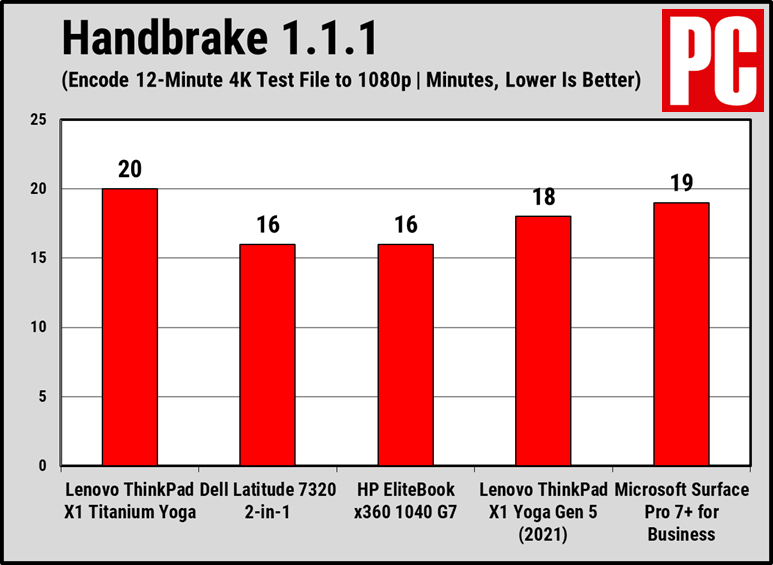
The X1 Titanium is equally competitive when it comes to Maxon’s CPU-crunching Cinebench test, which is also designed to make use of all available processor cores and threads. Cinebench stresses the CPU rather than the GPU to render a complex image.
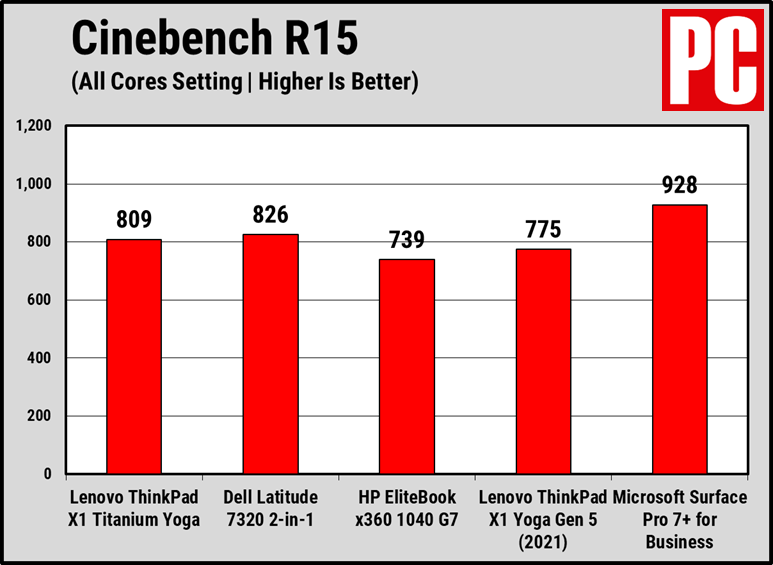
The results of our Photoshop image editing benchmark bear a close resemblance to the video encoding and rendering trials. The X1 Titanium again finished last, but the margins are small enough that the deficiency shouldn’t worry prospective owners who might occasionally need to use their laptops to resize a photo.
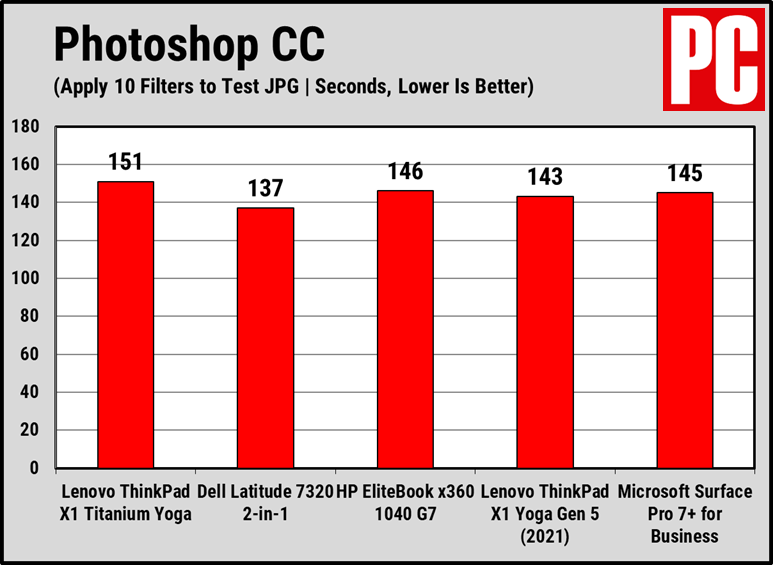
Play Games Elsewhere
In this work-from-home era, a lot of professionals are using their work laptops for things other than, well, work. Equipped with Intel’s latest Iris Xe Graphics processor, the X1 Titanium could be a platform for light gaming at the end of a serious work day. It’s far more capable than the UHD Graphics processors in the Dell and HP laptops, and thus performs better in our 3DMark and Superposition gaming graphics tests. These measure relative graphics muscle by rendering sequences of highly detailed, gaming-style 3D graphics that emphasize particles and lighting.
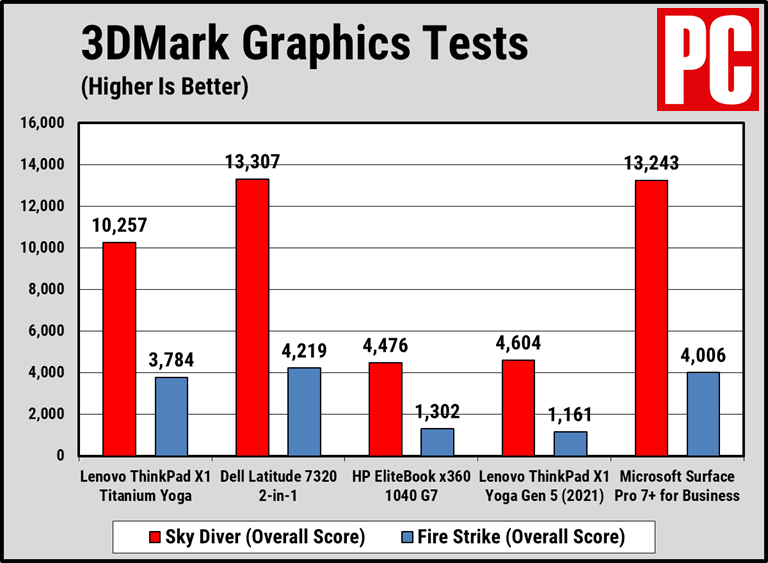
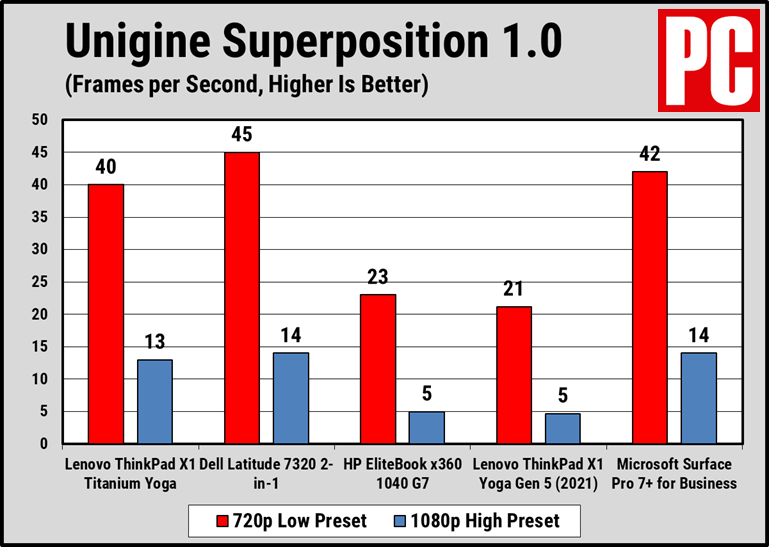
Still, it’s clear that other larger Iris Xe-equipped convertibles with more room for cooling can do better. The Latitude 7320 2-in-1 offers more than a 20% improvement over the X1 Titanium Yoga on the 3DMark Fire Strike test, which is more suited to laptops and midrange desktop PCs.
At more than 14 hours, the X1 Titanium’s time on on our video battery rundown test is about what we expect for a premium business laptop. Our test involves playing a locally stored video file with screen brightness set to 50% and Wi-Fi turned off until the battery dies. It’s a somewhat forgiving test, but nevertheless suggests that you should still be able to get a full day of work done on the X1 Titanium without plugging in.
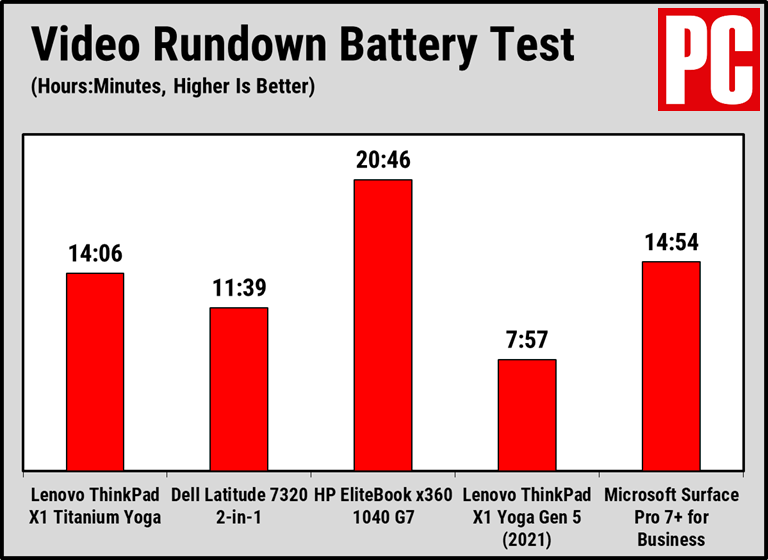
The Convertible of the Future
The ThinkPad X1 Titanium is a showcase of what Lenovo thinks business computing will look like in the near future. People want thinner, lighter laptops with high-quality screens and enough computing power to get their work done. The X1 Titanium achieves these goals with some controversial but innovative design choices, including a redesigned keyboard and a pared-down port selection.
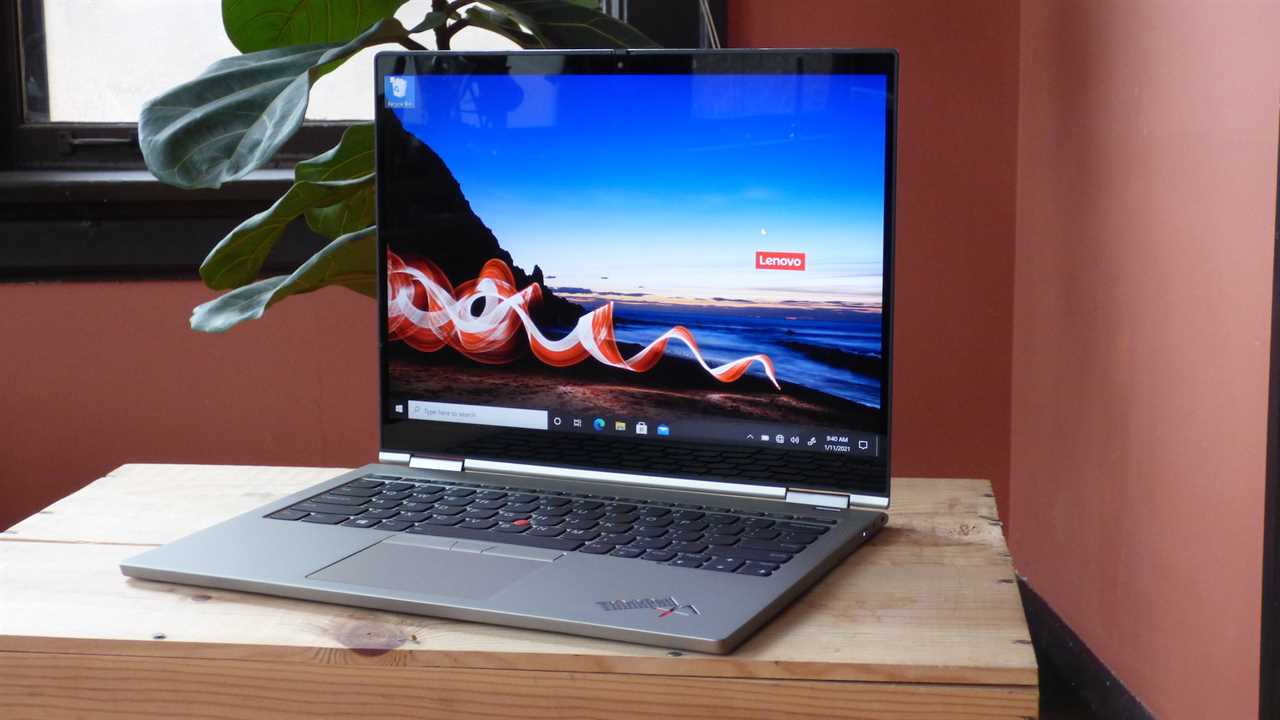
Will more 2-in-1 business laptops look like this next year? Probably, but we’d bet that the larger ThinkPad T series, as well as the ThinkPad X1 Yoga, will continue to be the go-tos in Lenovo’s lineup.


